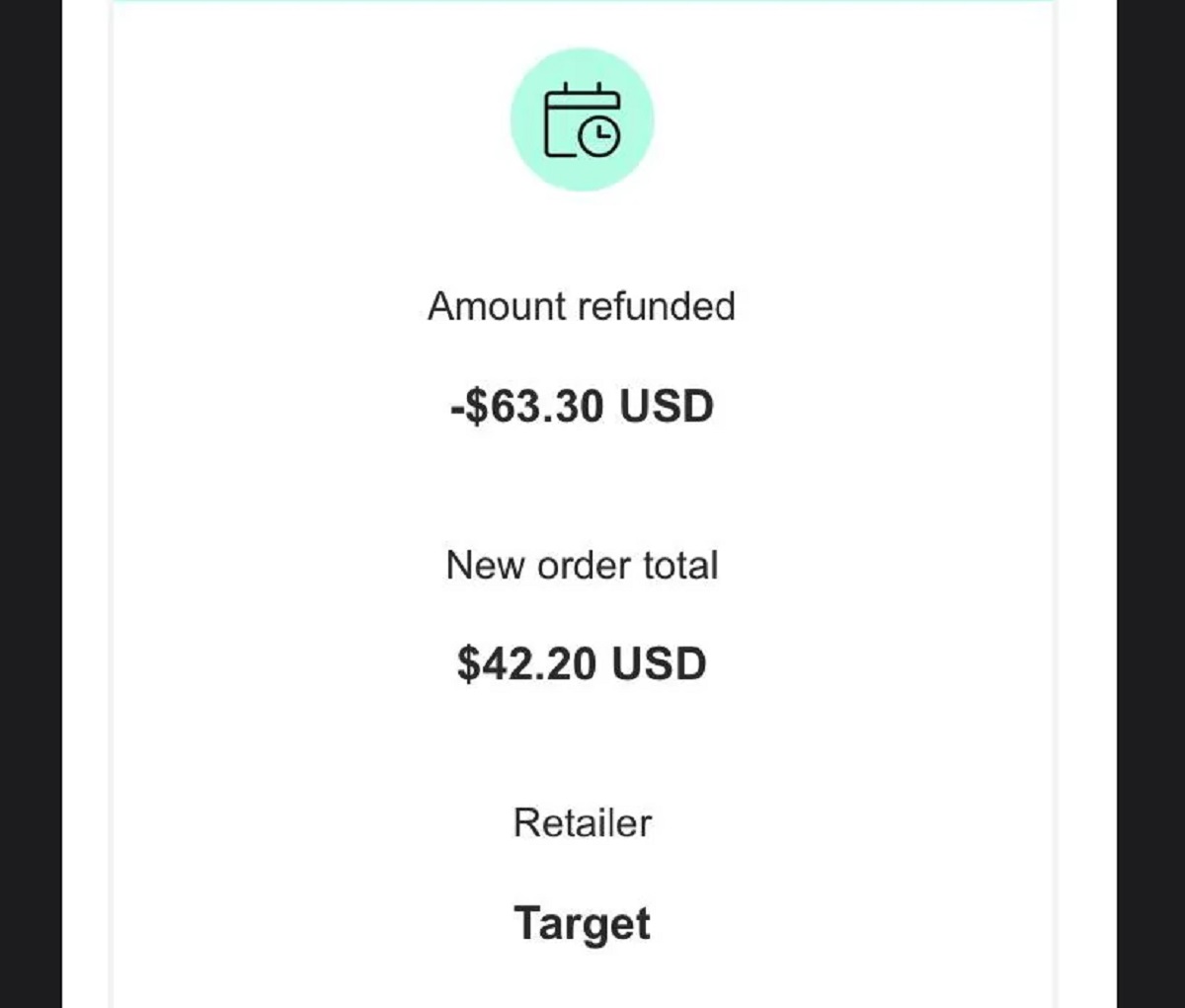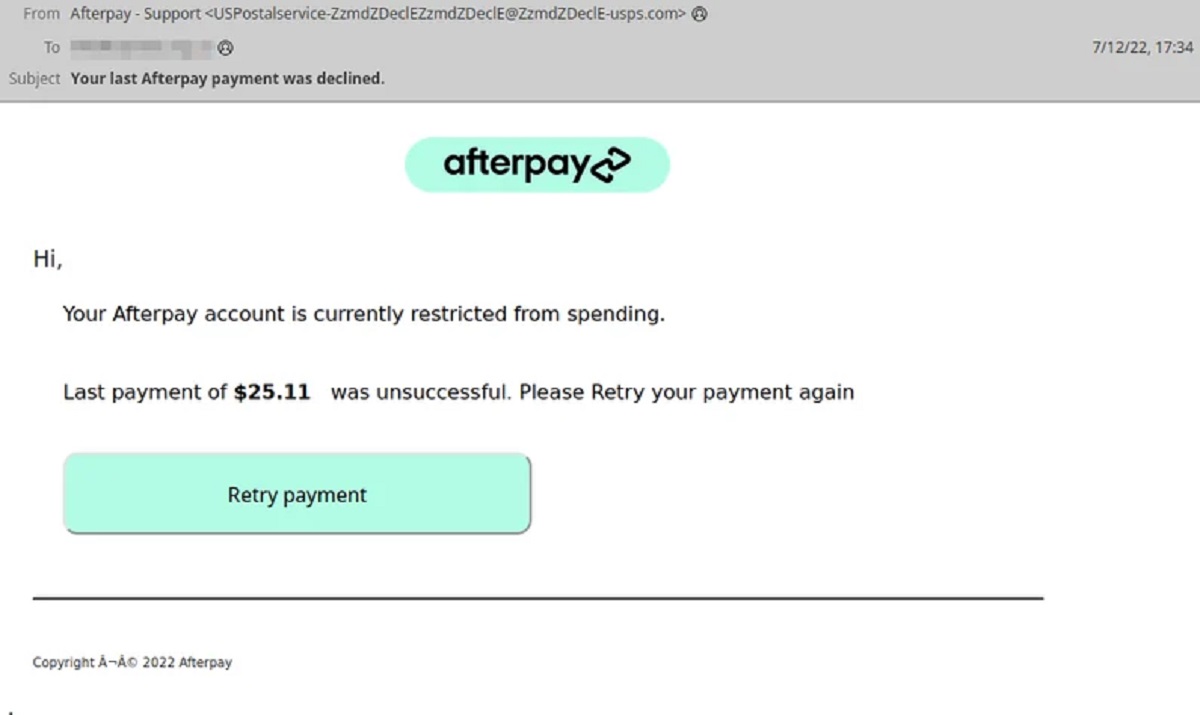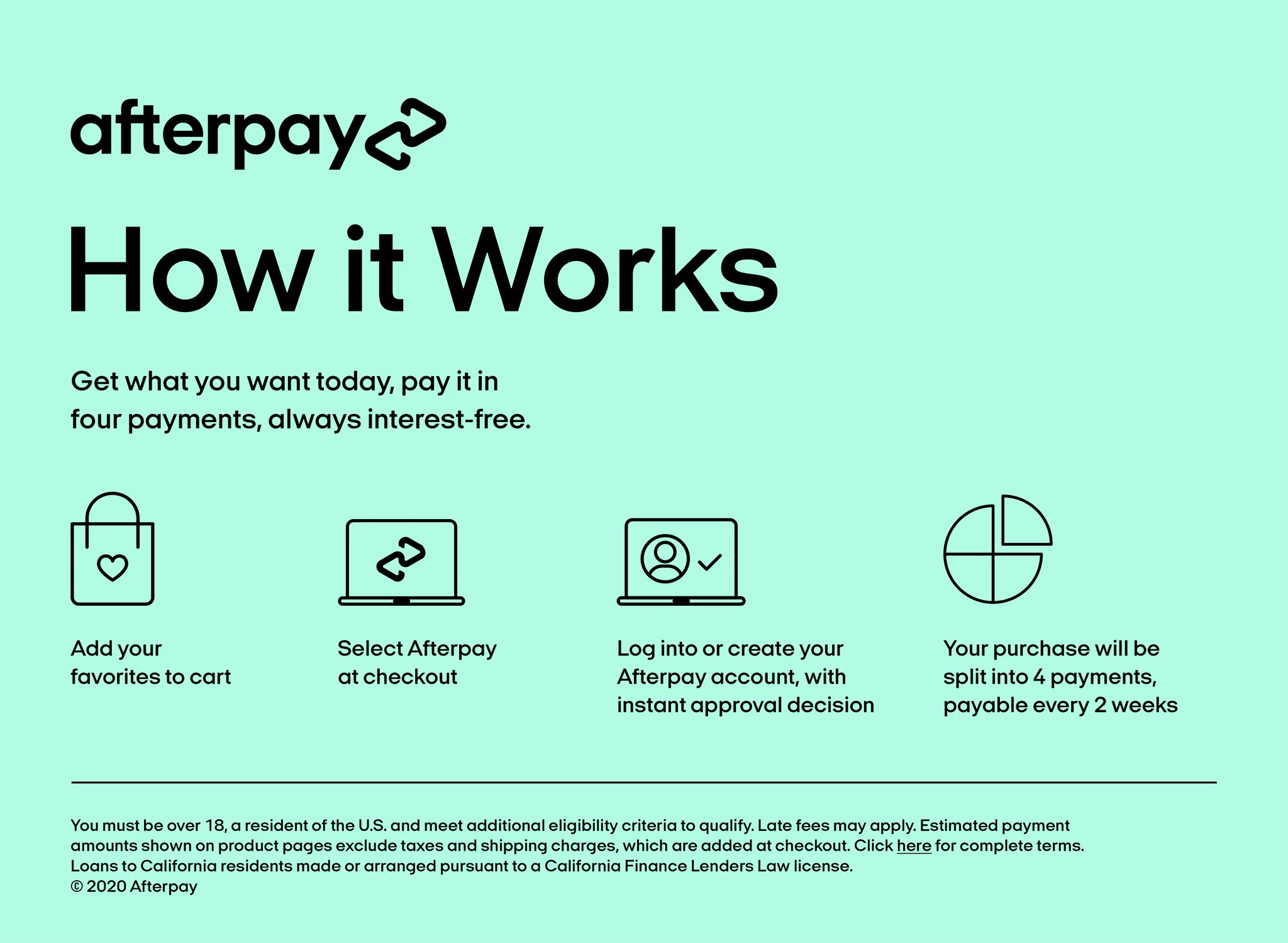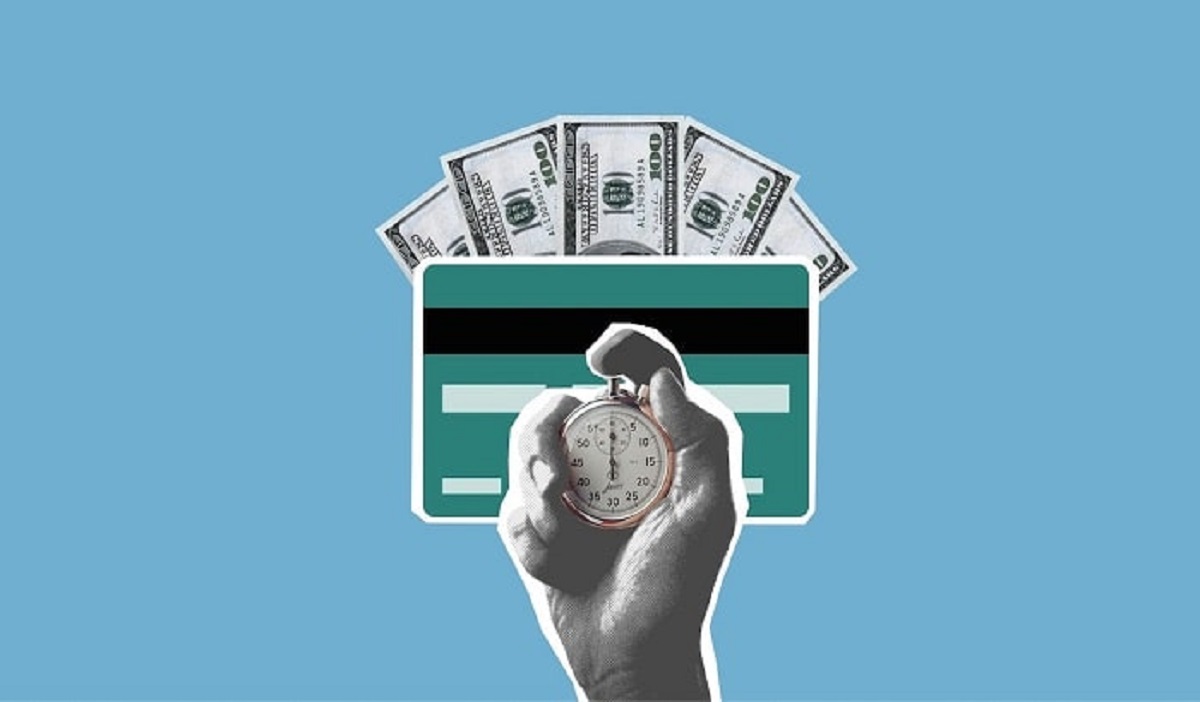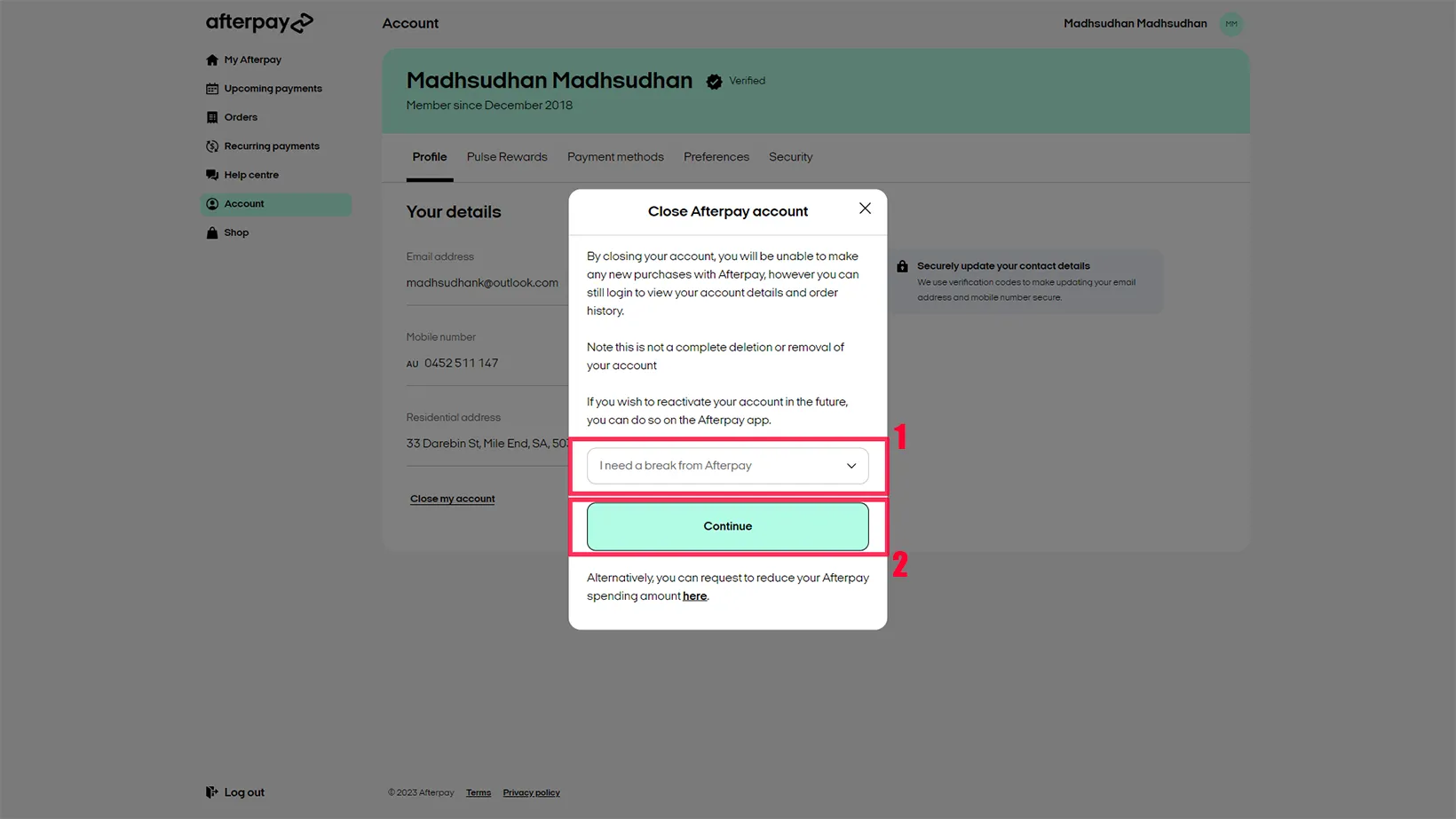Introduction
Shopping online has become increasingly popular, offering convenience and access to a wide range of products. With the rise of online shopping platforms, such as Afterpay, the process of purchasing items has become even more straightforward and accessible. Afterpay allows consumers to buy now and pay later, making it an attractive option for many shoppers.
However, there may be instances when you need to request a refund for your Afterpay purchase. Whether it’s due to receiving a faulty item, changing your mind, or any other reason, knowing the steps to request a refund can save you time and frustration.
In this article, we will guide you through the process of obtaining a refund from Afterpay, ensuring that you navigate the process smoothly. We will discuss the necessary steps, common issues you may encounter, and provide useful tips to increase your chances of a successful refund.
It’s important to note that the refund process may vary slightly depending on the specific retailer or merchant you made the purchase from. However, the general steps and principles outlined here will give you a solid foundation to start with.
So, if you find yourself in a situation where you need to seek a refund for your Afterpay purchase, read on to learn how to navigate the process effectively.
Understanding Afterpay Refunds
Before diving into the steps of requesting a refund from Afterpay, it’s essential to have a clear understanding of how Afterpay refunds work. Afterpay operates as a payment method that allows you to split your purchase into manageable installments, typically four equal payments over a specified period.
When it comes to refunds, Afterpay follows the refund policy of the retailer or merchant from whom you made the purchase. This means that the specific refund policies, including timeframes and conditions, may vary depending on the seller. It’s crucial to familiarize yourself with the retailer’s refund policy to ensure you know what to expect in terms of eligibility and requirements for a refund.
In general, Afterpay refunds work in the following way:
- When you request a refund, Afterpay will process the refund directly back to the original payment method used for the Afterpay installment plan.
- The refund will be applied to any outstanding payments first, reducing the amount you owe for future installments.
- If the refund exceeds the remaining payment balance, Afterpay will issue the remaining balance back to your original payment method.
It’s important to note that while Afterpay facilitates the refund process, they don’t have control over how long it takes for the refund to appear in your account. The time it takes for the refund to be processed and reflected in your original payment method may vary depending on the payment provider and can take anywhere from a few days to a few weeks.
Now that we have a basic understanding of how Afterpay refunds work, let’s move on to the steps you need to take to initiate a refund request.
Steps to Request a Refund from Afterpay
Requesting a refund from Afterpay involves a series of steps to ensure a smooth and successful process. By following these steps, you can increase your chances of receiving a refund for your purchase. Let’s take a closer look at each step:
Step 1: Gather Your Purchase Details
Before initiating a refund request, gather all the necessary information related to your purchase. This includes the order number, date of purchase, and any relevant receipts or documents. Having these details readily available will streamline the refund process.
Step 2: Contact the Retailer or Merchant
Reach out to the retailer or merchant from whom you made the purchase. Explain the reason for your refund request and inquire about their specific refund policy. They will provide you with instructions on how to proceed with the refund.
Step 3: Return or Exchange the Item
If the retailer requires you to return the item for a refund, carefully follow their instructions. Ensure that the item is in its original condition, with all tags and packaging intact. If you are eligible for an exchange instead of a refund, discuss your options with the retailer.
Step 4: Open a Dispute with Afterpay
If you encounter any issues with the retailer or merchant or need further assistance, you can open a dispute with Afterpay. Visit the Afterpay website or app and navigate to the dispute resolution section. Provide all necessary details regarding your refund request and previous communication with the retailer.
Step 5: Provide Evidence and Documentation
When opening a dispute with Afterpay, it’s crucial to provide any evidence and documentation that supports your refund claim. This may include photographs of the item, receipts, or any relevant correspondence with the retailer. The more evidence you can provide, the stronger your case will be.
Step 6: Finalizing the Refund Process
Afterpay will review your dispute and the provided evidence. They will then make a decision regarding your refund request. If approved, any remaining balance you owe will be adjusted, and the refund will be issued to your original payment method. Monitor your account for any updates and ensure the refund is processed accordingly.
By following these steps diligently and staying in communication with both the retailer and Afterpay, you can navigate the refund process smoothly and increase your chances of a successful refund for your Afterpay purchase.
Step 1: Gather Your Purchase Details
The first step to initiating a refund request from Afterpay is to gather all the necessary purchase details. Having this information readily available will streamline the refund process and ensure an efficient resolution. Here’s what you need to do:
1. Order Number: Locate the order number from the original purchase. This is typically provided in the confirmation email or receipt received at the time of purchase. The order number serves as a reference point for the retailer and Afterpay to identify your specific transaction.
2. Date of Purchase: Note down the date when you made the purchase. This is often mentioned in the email or receipt that was sent to you. The date of purchase is important, as it helps establish the timeline of the refund process.
3. Receipts and Documents: Compile and keep any relevant receipts or documents related to your purchase. This may include the original purchase receipt, order confirmation emails, or any other documentation provided by the retailer. These documents serve as proof of purchase and may be required during the refund process.
4. Product Details: Gather information about the item you are seeking a refund for. Take note of the product name, description, and any specific details such as color, size, or variant. This information will be useful when communicating with the retailer and Afterpay regarding your refund request.
Gathering these purchase details ensures that you have all the necessary information at your fingertips when initiating a refund request. This proactive approach will not only save you time but also enable a smoother and more efficient resolution process.
Remember to keep these purchase details in a safe place, as you may need to refer to them throughout the refund process. With your purchase details in hand, you are now ready to proceed to the next step and contact the retailer or merchant regarding your refund request.
Step 2: Contact the Retailer or Merchant
Once you have gathered your purchase details, the next step in the refund process is to contact the retailer or merchant from whom you made the purchase. This step is crucial as they are responsible for handling the refund based on their specific refund policy. Follow these guidelines when reaching out to them:
1. Identify the Correct Contact: Find the appropriate contact method to reach the retailer’s customer service team. This information is often available on their website, in the confirmation email, or on the packaging of the item. It may include a phone number, email address, or online chat option.
2. Explain Your Situation: Clearly communicate your reason for wanting a refund. Provide specific details about the purchase, such as the order number, date of purchase, and product information. Be concise but thorough in your explanation to ensure the retailer understands your request.
3. Inquire About the Refund Process: Ask the retailer about their specific refund policy. Inquire about any conditions, timeframes, or requirements they might have. Understanding their policy will help you navigate the process effectively and meet any necessary criteria for a refund.
4. Follow Instructions: The retailer may provide you with specific instructions on how to proceed with the refund. This may include returning the item, filling out a form, or providing additional documentation. Follow their instructions carefully to ensure a smooth refund process.
5. Keep Records of Communication: During your correspondence with the retailer, make sure to keep records of your communication. Save any emails or chat transcripts, or take notes during phone conversations. This documentation can be valuable if any issues arise during the refund process.
Remember to remain polite and professional when contacting the retailer or merchant. Being courteous and cooperative can facilitate a positive resolution to your refund request. If you encounter any difficulties or challenges during this step, don’t hesitate to escalate the matter or consult Afterpay for further assistance.
By contacting the retailer or merchant directly and following their instructions, you’re taking proactive steps towards resolving your refund request. Once you’ve discussed your refund with the retailer, proceed to Step 3 to find out the next course of action for returning or exchanging the item.
Step 3: Return or Exchange the Item
After contacting the retailer or merchant regarding your refund, you may need to return or exchange the item as per their specific instructions. This step is important to complete the refund process successfully. Follow these guidelines when returning or exchanging your item:
1. Follow the Retailer’s Return Policy: Review the retailer’s return policy to understand the requirements for returning or exchanging an item. This policy will typically detail conditions such as the timeframe for returns, the condition of the item, and any associated fees.
2. Package the Item Properly: When returning the item, package it securely and ensure it is in its original condition with all tags, labels, and accessories included. If the package doesn’t have a return label, contact the retailer for instructions on how to properly address and send the item back.
3. Consider Tracking and Insurance: It’s advisable to use a trackable shipping method and consider purchasing insurance for the parcel. This way, you can track the shipment and protect yourself in case the package gets lost or damaged during transit.
4. Obtain Proof of Return: Keep a record of your return by obtaining proof of return from the shipping carrier. This proof can be in the form of a receipt, tracking number, or confirmation of delivery. This will serve as evidence that you have returned the item in accordance with the retailer’s instructions.
5. Exchange Option: If you qualify for an exchange instead of a refund, follow the retailer’s exchange process. This may involve selecting a new item, confirming any price differences, and returning the original item as per their instructions.
6. Communicate with the Retailer: Stay in touch with the retailer throughout the return or exchange process. Notify them when you have shipped the item and provide them with any tracking information. This allows them to anticipate the arrival of the returned item and proceed with your refund or exchange promptly.
By adhering to the retailer’s return policy, properly packaging the item, and keeping open lines of communication, you can ensure a smooth return or exchange process. Once you have successfully returned or exchanged the item, proceed to Step 4 to open a dispute with Afterpay if needed.
Step 4: Open a Dispute with Afterpay
If you’ve encountered issues with the retailer or merchant or need further assistance with your refund request, you can open a dispute with Afterpay. Opening a dispute allows Afterpay to intervene and provide a resolution. Follow these steps to open a dispute with Afterpay:
1. Visit the Afterpay Website or App: Access the Afterpay website or open the Afterpay app on your mobile device. Navigate to the customer support or dispute resolution section, where you can find information on how to open a dispute.
2. Provide Required Information: Fill out the necessary forms and provide all relevant information regarding your purchase and refund request. Be detailed and accurate in your explanation, providing order details, reasons for the dispute, and any supporting evidence you may have.
3. Attach Supporting Documentation: In the dispute process, you may have the opportunity to attach any supporting documentation or evidence to strengthen your case. This can include photographs, receipts, emails, or any correspondence with the retailer regarding your refund request.
4. Submit the Dispute: Once you have completed the required information and attached any necessary documents, submit the dispute to Afterpay. Make sure to review all the details before submitting to ensure accuracy.
5. Monitor and Respond: After submitting the dispute, keep an eye on your email or notifications for updates from Afterpay. They may require additional information, clarification, or documentation to further investigate the dispute. Respond promptly and provide any requested information in a timely manner.
Opening a dispute with Afterpay allows them to step in and mediate between you and the retailer. Afterpay will review the details of your dispute, examine any evidence provided, and communicate with both parties involved in order to reach a resolution.
Remember to stay in communication with Afterpay throughout the dispute process. Respond to any requests or inquiries from them promptly, as this will help expedite the resolution of your refund request. If Afterpay approves your dispute and finds in your favor, they will proceed with the necessary adjustments to your payment plan or issue a refund accordingly.
By opening a dispute with Afterpay, you can seek their assistance in resolving any issues or challenges encountered during the refund process. Proceed to Step 5 to learn about the importance of providing evidence and documentation to support your refund claim.
Step 5: Provide Evidence and Documentation
When opening a dispute with Afterpay, it is essential to provide evidence and documentation to support your refund claim. This strengthens your case and helps Afterpay better understand the situation. Follow these guidelines when providing evidence and documentation:
1. Compile Relevant Proof: Gather any evidence that supports your refund claim. This may include photographs, videos, or any other visual evidence that clearly demonstrates the issue with the item. Additionally, collect any relevant documentation such as receipts, emails, or messages exchanged with the retailer regarding the refund.
2. Ensure Clarity and Quality: When submitting evidence, ensure that it is clear and of high quality. Blurry or unclear images may not serve the purpose effectively. Take clear photos or videos that clearly showcase the issue or defect with the item.
3. Provide a Detailed Explanation: Accompany the evidence with a detailed explanation of the problem or reason for your refund request. Clearly articulate the issues you’ve encountered, providing relevant dates, order numbers, and any other relevant details that can help Afterpay understand the situation better.
4. Be Honest and Transparent: It is crucial to be honest and transparent when providing evidence and documentation. Misrepresenting information or providing false evidence can harm your case and may have consequences. Stick to the facts and provide accurate information to ensure a fair evaluation of your refund claim.
5. Follow Afterpay’s Instructions: When submitting evidence, make sure to follow Afterpay’s instructions regarding the format or method they prefer. They may require you to upload documents through their website or provide specific instructions on how to send the evidence. Adhering to their guidelines ensures that your evidence is properly received and considered.
By providing relevant evidence and documentation, you present a compelling case to Afterpay, demonstrating the validity of your refund claim. This helps them make an informed decision regarding your dispute and increases the likelihood of a successful resolution.
Remember to keep copies of all the evidence and documentation you submit, as well as any communication with Afterpay. This will serve as a record of your efforts and can be helpful if any further inquiries arise during the dispute resolution process.
With Step 5 completed, you have taken an important step in supporting your refund claim. Proceed to Step 6 to learn about finalizing the refund process with Afterpay.
Step 6: Finalizing the Refund Process
Once you have opened a dispute with Afterpay and provided the necessary evidence and documentation, it’s time to finalize the refund process. Afterpay will review the dispute, consider the evidence provided, and make a decision regarding your refund claim. Follow these guidelines to complete this step:
1. Monitor your Communication: Keep an eye on your email or notifications for updates from Afterpay. They may reach out to you for additional information or provide updates on the progress of your dispute. Promptly respond to any inquiries or requests to ensure a smooth resolution process.
2. Follow Afterpay’s Instructions: If Afterpay requests any additional documentation or information, provide it as soon as possible. Follow their instructions closely to ensure your refund claim is accurately evaluated. Cooperate with Afterpay throughout the process to facilitate a positive outcome.
3. Review the Decision: After considering all the evidence and information, Afterpay will make a decision regarding your refund claim. They will inform you of the decision through email or other means of communication. Review the decision carefully to understand the outcome and any applicable actions you need to take.
4. Payment Adjustments or Refund: If Afterpay approves your refund claim, they will make the necessary adjustments to your payment plan. This may involve reducing the remaining installment amounts or issuing a refund to your original payment method. Monitor your Afterpay account and your original payment method for any updates or changes.
5. Keep Records of the Resolution: Once the refund process is finalized, it is important to keep records of the resolution. Save any emails or communication from Afterpay regarding the outcome of your dispute. This will serve as evidence should any issues arise in the future.
Throughout this step, maintain open lines of communication with Afterpay and follow their guidance. Respond promptly, provide any requested information, and remain patient as the refund process may take some time to complete.
With Step 6 completed, you have reached the final stage of the refund process. However, if you encounter any common issues or challenges during the refund process, continue reading to Step 7 for guidance on how to resolve them.
Common Issues and How to Resolve Them
While the refund process with Afterpay is typically smooth, there are a few common issues that may arise. It’s important to be aware of these challenges and understand how to address them effectively. Here are some common issues and their potential resolutions:
Issue 1: Delayed Refund from Afterpay: Afterpay aims to process refunds promptly, but there may be instances of delays. If you have not received your refund within the expected timeframe, reach out to Afterpay’s customer support. Provide them with your dispute details and inquire about the status of your refund. They can investigate the matter and provide you with an update.
Issue 2: Disputes with the Retailer or Merchant: If you encounter challenges or disagreements with the retailer or merchant during the refund process, continue to communicate with them in a calm and professional manner. Clearly articulate your concerns and refer to their refund policy when necessary. If communication proves to be unproductive, escalate the matter to Afterpay by providing them with a detailed account of the situation.
Issue 3: Afterpay Denying the Refund Request: In certain cases, Afterpay may deny a refund request after reviewing the dispute. If this occurs, carefully review the reasons provided by Afterpay for the denial. If you believe their decision is incorrect or unfair, you can respond to their communication and provide additional evidence or clarification to support your case. Engage in a respectful dialogue and be persistent in expressing your concerns.
If you continue to face challenges in resolving any of these issues, consider seeking advice from consumer protection organizations or legal experts who can guide you through the process and provide additional support if necessary.
Remember to remain patient and persistent throughout the resolution process. By maintaining effective communication and actively addressing any issues, you increase your chances of achieving a successful outcome for your refund claim.
Now that we have discussed common issues and how to address them, let’s move on to some useful tips that can help you navigate the refund process successfully. Read on to Step 8 for these valuable tips.
Issue 1: Delayed Refund from Afterpay
While Afterpay aims to process refunds promptly, there may be instances where the refund gets delayed. If you find yourself waiting longer than expected for your refund to be processed, follow these steps to address the issue:
1. Review the Expected Timeframe: Check the refund policy provided by Afterpay or the retailer to ascertain the expected timeframe for the refund process. Ensure that the current delay falls outside the expected timeline before taking further action.
2. Contact Afterpay Customer Support: Reach out to Afterpay’s customer support team through their website or app to inquire about the status of your refund. Provide them with your dispute details, including the order number and any other relevant information. They can investigate the matter and provide you with an update on the progress of your refund.
3. Keep Track of Communication: Document your communication with Afterpay, including the date and time of contact, the customer support representative’s name, and any reference numbers provided. This will help you keep a record of the steps you have taken to address the delayed refund.
4. Persist in Follow-up: If you do not receive a satisfactory response or resolution from Afterpay’s initial response, persist in following up with them. Politely request further updates and emphasize the importance of receiving a timely refund. Be persistent but remain courteous and professional throughout the process.
5. Seek Additional Assistance: If your refund continues to be delayed despite your efforts, consider seeking assistance from consumer protection organizations or legal experts who can provide guidance and support in addressing the issue. They may be able to intervene on your behalf and help expedite the refund process.
Remember that refund processing times can vary depending on various factors, including the retailer’s processing time, payment provider procedures, and other external circumstances. While delays can be frustrating, being proactive in addressing the issue and maintaining open communication with Afterpay will increase your chances of a prompt resolution.
By following these steps, you can address the issue of a delayed refund from Afterpay and work towards achieving a satisfactory resolution. Proceed to the next section for guidance on resolving disputes with the retailer or merchant.
Issue 2: Disputes with the Retailer or Merchant
Encountering disputes or disagreements with the retailer or merchant during the refund process can be challenging. However, by approaching the situation with a calm and proactive mindset, you can work towards a resolution. Follow these steps to address disputes with the retailer or merchant:
1. Review the Refund Policy: Familiarize yourself with the retailer’s refund policy to understand their terms and conditions. Make sure to review the specific guidelines for requesting a refund and any associated timelines or requirements. This will help you better navigate the dispute resolution process.
2. Communicate Clearly: Reach out to the retailer or merchant and clearly articulate the issue or reason for your refund request. Provide specific details and any relevant supporting evidence, such as order numbers, product descriptions, or photographs. Clearly explaining your concerns will help the retailer understand your perspective.
3. Refer to the Refund Policy: If the retailer or merchant is disputing your refund request, refer them back to their own refund policy. Highlight any clauses or conditions that support your entitlement to a refund. This can help steer the discussion towards a resolution and ensure that the retailer adheres to their own policies.
4. Be Persistent but Polite: Maintain a polite and respectful tone throughout your communication with the retailer. Express your concerns and expectations clearly, but avoid becoming confrontational or aggressive. Being persistent in addressing the issue without resorting to negativity can often result in a more amicable resolution.
5. Escalate the Matter: If you are unable to reach a resolution with the retailer or merchant directly, consider escalating the dispute to Afterpay. Provide Afterpay with a detailed account of the situation, including your previous communication with the retailer. Afterpay may be able to mediate between you and the retailer to find a solution.
6. Seek External Assistance if Necessary: If all attempts to resolve the dispute directly with the retailer are exhausted, consider seeking assistance from consumer protection organizations or legal experts. They can provide guidance on your rights as a consumer and may be able to intervene on your behalf to help reach a fair resolution.
Remember to document all communication with the retailer or merchant, including dates, times, and details of discussions. This documentation will serve as evidence if the dispute needs to be escalated further.
By following these steps and persevering through disputes with the retailer or merchant, you increase your chances of resolving the issue and obtaining the refund you are entitled to.
Proceed to the next section to find guidance on what to do if Afterpay denies your refund request.
Issue 3: Afterpay Denying the Refund Request
Discovering that Afterpay has denied your refund request can be frustrating. However, there are steps you can take to address the situation and potentially achieve a favorable outcome. Follow these guidelines when Afterpay denies your refund request:
1. Review the Reasoning: Carefully review the reasons provided by Afterpay for denying your refund request. Take note of any specific explanations or requirements mentioned. Understanding their reasoning will help you determine the best course of action moving forward.
2. Assess the Decision: Evaluate whether Afterpay’s decision is fair and justified based on the evidence and information you provided. Consider whether there are any missing pieces of documentation or if further clarification is needed to reinforce your case.
3. Respond to Afterpay: If you believe Afterpay’s decision is incorrect or unfair, you have the option to respond to their communication. Respectfully express your concerns and provide any additional evidence or clarification that supports your refund claim. Be concise in your response and focus on addressing the specific points raised by Afterpay.
4. Engage in Dialogue: Engage in a respectful dialogue with Afterpay’s customer support team. Clearly and calmly communicate your perspective and advocate for the fairness of your refund request. Request a review of their decision based on the evidence and information you have provided.
5. Seek Supervisor or Manager Assistance: If you are unable to reach a satisfactory resolution with the customer support team, escalate your concerns to a supervisor or manager at Afterpay. They may have additional insights or authority to re-evaluate your refund request and address your concerns in a more comprehensive manner.
6. Consider External Assistance: If all attempts to resolve the issue with Afterpay are unsuccessful, consider seeking assistance from consumer protection organizations or legal experts who specialize in consumer rights. They can provide guidance and support, and in some cases, negotiate on your behalf to achieve a fair resolution.
Throughout the process, maintain a calm and professional demeanor, even if frustrations arise. Polite and respectful communication will help establish a constructive dialogue and increase the likelihood of finding a resolution.
By following these steps and persisting in addressing Afterpay’s decision, you may be able to successfully advocate for your refund claim and achieve a favorable outcome.
Proceed to the next section for useful tips that can help you increase your chances of a successful refund process.
Useful Tips for a Successful Refund Process
Navigating the refund process can be a complex and sometimes challenging task. However, by following these useful tips, you can increase your chances of a successful refund and ensure a smooth resolution:
1. Keep Track of Deadlines and Dates: Pay close attention to refund request deadlines specified by the retailer or merchant. Submit your refund request within the designated timeframe to avoid missing out on a refund opportunity. Additionally, keep track of important dates such as the date of purchase, shipping dates, and any communication with the retailer or Afterpay to maintain a clear timeline of events.
2. Maintain Effective Communication: Open and clear communication is crucial throughout the refund process. Respond promptly to any inquiries or requests from the retailer or Afterpay. Ensure that your messages are concise, polite, and provide all the necessary information. By keeping the lines of communication open, you can quickly address any issues that arise and facilitate a smoother resolution.
3. Familiarize Yourself with Refund Policies: Take the time to familiarize yourself with the refund policies of both the retailer and Afterpay. Understand the specific conditions, timeframes, and requirements for a refund. By understanding these policies, you can navigate the process more effectively and ensure that you meet all the necessary criteria.
4. Provide Clear Evidence and Documentation: When requesting a refund, provide clear and compelling evidence to support your claim. This can include photographs, videos, receipts, or any other relevant documentation. Make sure the evidence is well-documented, of good quality, and clearly highlights the issue or reason for your refund request.
5. Be Patient and Persistent: The refund process may take some time, and there may be instances where challenges arise. Be patient, but also persistent in advocating for your rights. Follow up with the retailer or Afterpay if there are delays or lack of progress. Stay proactive throughout the process to ensure that your refund claim is prioritized.
6. Understand Payment Adjustments: If your refund request is approved, understand how Afterpay will adjust your payment plan. Be aware of any changes in remaining installment amounts or due dates. This will help you maintain clarity and avoid any confusion or missed payments.
By following these tips, you can approach the refund process with confidence and increase your chances of a successful resolution. Remember to stay organized, be proactive, and remain persistent in advocating for your refund rights.
Now that you have these valuable tips, you are well-equipped to navigate the refund process effectively. Keep them in mind as you proceed with your refund request.
Tip 1: Keep Track of Deadlines and Dates
One of the most important tips for a successful refund process is to keep track of deadlines and dates associated with your refund request. By staying organized and mindful of key timelines, you can ensure that you submit your refund request on time and avoid missing out on the opportunity for a refund. Here’s how to effectively manage deadlines and dates:
1. Note the Refund Request Deadline: When making a purchase, take note of any specific refund request deadlines mentioned by the retailer or merchant. This deadline is typically outlined in their refund policy or terms and conditions. Mark this date in a calendar or set a reminder to ensure you submit your refund request before it expires.
2. Monitor the Return Window: If the retailer requires you to return the item for a refund, pay close attention to the return window specified in their refund policy. This is the timeframe within which you must initiate the return process. Missing this window may result in your refund request being denied. Set a reminder to ensure you initiate the return on time.
3. Keep Track of Shipping Deadlines: If returning the item is necessary, be aware of any shipping deadlines outlined by the retailer. Ensure that you ship the item back within the specified timeframe to avoid delays or potential problems with your refund request. Keep a record of the shipping confirmation or receipt as proof of timely return.
4. Record Important Dates: Throughout the refund process, maintain a record of important dates such as the date of purchase, date of initiating the refund request, and any communication dates with the retailer or Afterpay. Having a clear timeline of events can help you track the progress of your refund and address any issues that may arise.
5. Set Reminders and Notifications: Use digital tools such as calendar apps or task management apps to set reminders and notifications for important refund-related dates. This will help you stay on top of deadlines and ensure that you take timely action when necessary.
By staying organized and keeping track of deadlines and dates, you demonstrate your commitment to the refund process. This helps ensure that you meet the required timeframes and maximize your chances of a successful refund outcome.
Now that you understand the importance of managing deadlines and dates, let’s move on to the next tip: maintaining effective communication throughout the refund process.
Tip 2: Maintain Effective Communication
Effective communication is crucial during the refund process to ensure a smooth and successful resolution. By maintaining clear and timely communication with the retailer, Afterpay, and any other relevant parties, you can stay informed and address any issues that may arise. Here are some tips for maintaining effective communication:
1. Respond Promptly: When you receive a communication from the retailer or Afterpay regarding your refund request, respond in a timely manner. Prompt responses show your commitment and cooperation in resolving the issue. Aim to reply within one to two business days, or sooner if possible, to avoid any unnecessary delays.
2. Be Clear and Concise: Clearly articulate your concerns, questions, or requests in your communication. Be concise but provide sufficient information to ensure your message is understood. Use precise language and avoid ambiguity to minimize the chance of miscommunication.
3. Use Polite and Professional Tone: Maintain a polite and professional tone throughout your communication. Even if you encounter challenges or frustrations, refrain from using aggressive or confrontational language. A respectful approach fosters a productive and respectful dialogue, increasing the likelihood of a positive resolution.
4. Keep Copies of Communication: Save copies of all communication related to your refund request, including emails, chat transcripts, and any written correspondence. This documentation serves as a record of your efforts and can be useful if there are any questions or disputes later in the process.
5. Follow Instructions and Guidelines: Read and follow any instructions or guidelines provided by the retailer or Afterpay when communicating with them. Adhering to their protocols demonstrates your commitment to the process and helps streamline the communication flow.
6. Keep Afterpay Informed: If you experience challenges or disputes with the retailer, keep Afterpay informed about the situation. Provide them with clear and accurate updates, including any relevant communication or documentation. Afterpay can assist in mediating the dispute and finding a resolution.
Communicating effectively throughout the refund process shows your dedication to resolving the issue and increases your chances of achieving a satisfactory outcome. Keep record of all communication, follow protocols, and maintain a professional tone to facilitate a positive resolution.
Now that you understand the importance of effective communication, let’s move on to the next tip: familiarizing yourself with refund policies.
Tip 3: Familiarize Yourself with Refund Policies
Understanding the refund policies of the retailer and Afterpay is essential for a smooth refund process. By familiarizing yourself with these policies, you can navigate the process effectively and ensure you meet all the necessary requirements. Here are some tips for familiarizing yourself with refund policies:
1. Read the Retailer’s Refund Policy: Take the time to thoroughly read and understand the refund policy of the retailer from whom you made the purchase. Familiarize yourself with the specific conditions, timeframes, and requirements for a refund. Pay attention to any exclusions or limitations mentioned in the policy.
2. Review Afterpay’s Refund Policy: Visit the Afterpay website or app and familiarize yourself with their refund policy. Understand how Afterpay handles refunds and any specific guidelines or rules they have in place. This will help you understand their role in the refund process and the steps you need to take in conjunction with the retailer.
3. Note Key Requirements: Make a note of any important requirements outlined in the refund policies, such as the deadline for requesting a refund, the condition of the item, or any documentation needed to process the refund. Being aware of these requirements will help you ensure you meet them and avoid any complications later in the process.
4. Clarify Ambiguities: If you come across any unclear or ambiguous aspects of the refund policies, don’t hesitate to seek clarification. Reach out to the retailer’s customer support or Afterpay’s customer service team to address any questions or concerns you may have. Having a clear understanding of the policies will help you navigate the refund process confidently.
5. Refer to Policies During Communication: When communicating with the retailer or Afterpay regarding your refund, refer back to their refund policies as needed. It can help reinforce your entitlement to a refund and ensure that your requests align with their stated guidelines. Being informed about the policies will strengthen your position during the discussions.
By familiarizing yourself with the refund policies of both the retailer and Afterpay, you empower yourself with the knowledge necessary to navigate the refund process effectively. Understanding the requirements and limitations outlined in the policies will help you take the appropriate actions and make informed decisions.
Now that you are familiar with refund policies, let’s move on to the next section and discuss some common issues that may arise during the refund process and how to resolve them.
Conclusion
Navigating the refund process with Afterpay can be a straightforward and successful experience when you follow the right steps and adopt useful tips. By understanding Afterpay’s refund policies, maintaining effective communication, and being proactive in resolving issues, you can increase your chances of a smooth and satisfactory refund outcome.
Remember to gather all the necessary purchase details, such as order numbers and receipts, before contacting the retailer or merchant. Communicate your refund request clearly, and follow any instructions or return procedures provided by the retailer. If you encounter any challenges, open a dispute with Afterpay and provide them with evidence and documentation to support your claim.
Throughout the refund process, keep track of deadlines and important dates, respond promptly to communications, and maintain a professional and polite tone. Familiarize yourself with all refund policies to ensure you meet the necessary requirements and understand the guidelines laid out by both the retailer and Afterpay. Stay persistent and seek additional assistance if needed.
By implementing these strategies and tips, you can navigate the refund process successfully, ensuring a seamless experience with Afterpay. Remember to keep all documentation and communication records for reference and be patient, as the process may take time.
As a skilled SEO writer, I have provided you with valuable insights and guidance to help you obtain a refund from Afterpay. Apply these strategies, adapt them to your specific situation, and always stay informed about any changes or updates to Afterpay’s policies.
Now, armed with knowledge and confidence, you are ready to embark on the refund process with Afterpay. Wishing you a successful resolution and a positive customer experience!







